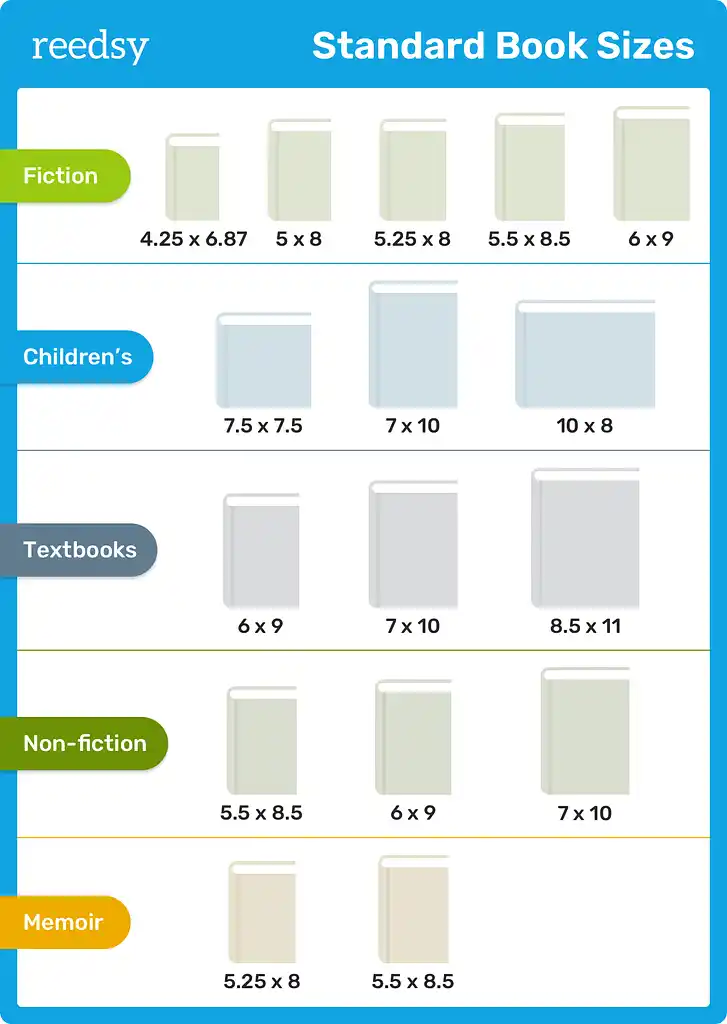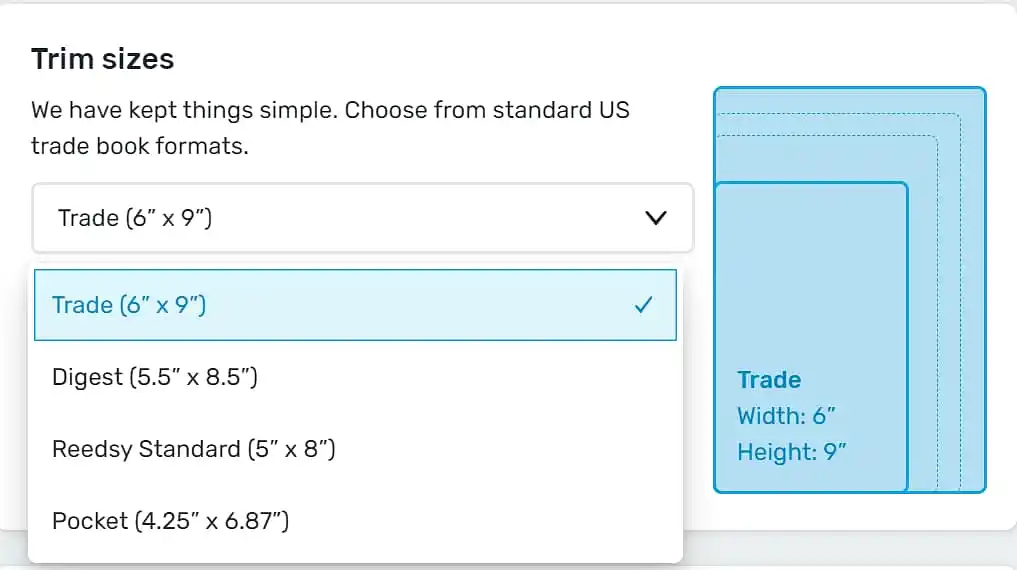Posted on September 06, 2024 13:03
What Are the Standard Book Sizes in Publishing?
Books come in all shapes and… sizes. Some are small and portable, while others are large and imposing. Publishers carefully select dimensions, balancing economic, practical, and artistic factors. And if you're an indie author planning to print and distribute your book, you'll likely need to weigh these same types of considerations.
In this post, we'll walk you through the industry-standard book sizes, explain why they matter, and highlight key factors to consider when selecting the perfect trim size for your book.
What are the standard book sizes in publishing?
In publishing, "trim size" refers to the final dimensions of a book after it's printed and the pages are cut — or trimmed — to ensure uniformity. It is expressed as Width x Height and measured in inches in the U.S. and in millimeters in Europe (for this post, we'll stick with U.S. measurements).
Below are the most popular standard book sizes for their respective genres, in inches:
- Fiction: 4.25 x 6.87, 5 x 8, 5.25 x 8, 5.5 x 8.5, 6 x 9
- Children’s: 7.5 x 7.5, 7 x 10, 10 x 8
- Textbooks: 6 x 9, 7 x 10, 8.5 x 11
- Non-fiction: 5.5 x 8.5, 6 x 9, 7 x 10
- Memoir: 5.25 x 8, 5.5 x 8.5
And here is a visual representation for comparison:

As you see, standard book sizes vary depending on genre. To give you a better understanding of the numbers, let's consider them in the context of familiar industry terms.
- Mass-market paperbacks: Compact and affordable, these are also known as “pocket” books. They typically measure around 4.25” x 6.87” and are commonly found in grocery store racks.
- Trade paperbacks: Higher in print quality, these are the books you'd find at places like Barnes & Noble. Trade paperbacks range from 5.5” x 8.5” (digest size) to 6” x 9” (trade size). Many novels, memoirs, and non-fiction titles today fall within this range.
- Hardcover: Known for their premium feel, hardcover books generally range from 6” x 9” to 8.5” x 11”.
Here’s a real-world comparison of some trade paperback sizes:

If you’re self-publishing your book and you want to format it in one of these popular sizes, you should know that Reedsy Studio — our free writing app — allows you to export your manuscript in four sizes:
- Pocket: 4.25 x 6.87 in (10.80 x 17.45 cm)
- Reedsy: 5 x 8 in (12.7 x 20.32 cm)
- Digest: 5.5 x 8.5 in (13.97 x 21.59 cm)
- Trade: 6 x 9 in (15.24 x 22.86 cm)

In just a few clicks, you can create a perfectly sized manuscript that’s ready for distribution on platforms like Amazon and IngramSpark. Speaking of which, make sure that your chosen trim size is accepted by the distribution platform you'll use to print and sell your book. You can find more information here:
On that note: why is trim size so important, and how do you pick the right one for your book? Let’s delve into this in more detail below.
Why does trim size matter?
A book’s trim size will impact several aspects of the final product, including page count and readability, cover design and presentation, marketability, and printing costs.
Page count and readability
If you imagine your physical book as a house, then the trim size marks its borders. It bolts in the size of your “real estate,” and influences both the interior and exterior of your book. In short, it will determine how many words fit on a page, and therefore your page count. A smaller trim size means you’ll need more pages to fit your manuscript, and vice versa.
So, in general, the more words in your manuscript, the larger your book’s trim size can be. For example, The Hunger Games has 101,900 words and a trade paperback size of 5.5” x 8.5”. Conversely, if your book is shorter, a smaller trim size can make it feel more substantial. The Sun Also Rises by Ernest Hemingway, at 67,707 words, has a relatively compact 5.2” x 8” frame in its Penguin Classics edition.
Overall, you want to avoid cramming too many words onto each page. Instead, you should aim for balanced, visually appealing typesetting that enhances the reading experience.

If you use a writing tool like Studio, you won’t have to worry about these details. It automatically adjusts your paragraphs, titles, images, and more based on the trim size you choose to export, ensuring your manuscript looks professional no matter what. (Unless you're working with a particularly complex interior design, like technical books with lots of graphs or uniquely illustrated novels, in which case you may need to consult a professional typesetter.)
As mentioned, trim size also impacts the book’s exterior…
Cover design and presentation
The trim size you select will also affect your book's cover dimensions and overall presentation. In fact, the balance of graphic elements changes with size — you can't simply shrink the typography on a small cover to fit everything in, because it will no longer look proportionate. But if you prioritize text readability, the space available for images will decrease.
Overall, complex, detail-rich images might work well on a larger cover, but can look cluttered and hard to read on a smaller one.
If you’re working on your cover with a professional designer, you’ll need to tell them ahead of time what size you want your cover to be. Each print-on-demand service will also have specific requirements for print cover files. Here are useful tools from two of the most popular retailers:
- Amazon's KDP has a Cover Calculator that can help you determine the necessary dimensions of your cover file.
- IngramSpark has a similar Cover Template Generator which will allow you to determine the ideal measurements for your paperback and hardcover editions.
Printing costs
Another crucial reason to carefully consider your trim size is that it directly impacts your printing costs. Print-on-demand services charge based on page count, which, as we’ve seen, is influenced by the trim size. So the trim size of your book can have a ripple effect on your profit margin. Larger books mean fewer pages, which can lower your costs, and vice versa.
But while that might make a bigger trim size (and fewer pages) seem tempting, you shouldn’t automatically opt for the cheapest option. Think about your audience: would your average reader find it easy to carry around a 6" x 9" book? Perhaps not. If you're aiming for portability, a size like 5.5" x 8.5" might be a better fit.
And again, think about word count: if your book is under 75,000 words or so, you’ll want a smaller trim size so the book doesn’t look too insubstantial. In this case, the higher cost of printing more pages will be offset by having a more “sellable” product.
This leads us to the final, and perhaps most crucial, factor: what’s standard in your genre.
Marketability
When readers hunt for their next book, they're often drawn to the familiar. "This book reminds me of that one I loved — I should give it a try!" So if you're publishing a Harlequin-style romance novel but opt for an unusual 9" x 7" trim size, you might throw genre fans for a loop — and not in a good way.
Most authors choose a trim size that aligns with mainstream trade paperback releases in their category, and for good reason. Your best marketing strategy (in most cases) is to meet potential readers' expectations.
Which is great news for picking your book’s size…
How should I pick my book’s trim size?
You could easily spend hours in a bookstore, picking up books of different trim sizes to see how they feel. Are they clunky or just right? Does the content fit nicely on the pages? When you put the book back, does it stand out or blend in with others in your genre? This is a great way to get familiar with industry standards. But ultimately, your choice will come down to a combination of the factors we discussed, particularly your genre’s expectations and your novel’s length.
We hope this post made the topic of trim sizes less intimidating and confusing, and that it’ll help you confidently pick the right one for your book.


